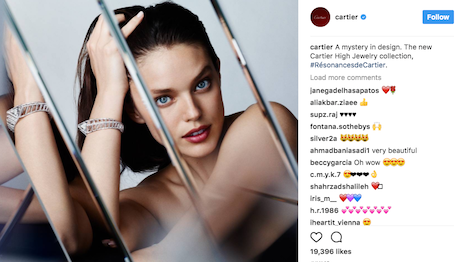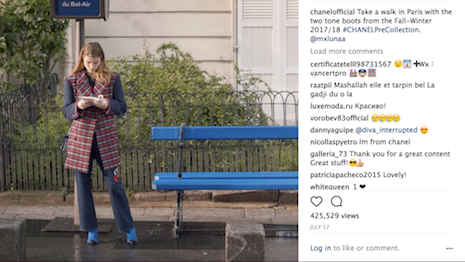- About
- Subscribe Now
- New York,
September 22, 2017

 Cartier showcasing its High Jewelry collection to its 5.6 million followers on Instagram. Image credit: Cartier
Cartier showcasing its High Jewelry collection to its 5.6 million followers on Instagram. Image credit: Cartier
Luxury brands that embrace social content and really tap into the lifestyle experience it can provide are miles ahead of those who lack similar strategies.
PMX Agency’s Trend Report: Luxury Brands Online reveals that in the past year, social media followers of luxury brands have grown by 27 percent. Chanel has consecutively held the spot of the brand with the largest Instagram follower growth year over year for three years in a row.
“There has been a definitive shift in the luxury consumer,” said Chris Paradysz, co-CEO and founder of PMX Agency, New York. “Luxury brands must be willing to constantly experiment.
“Fear of risk taking can’t overcome learning more about their existing and prospective customers,” he said.
Brand growth
Chanel’s Instagram following grew by 9.5 million users in the past year. PMX attributes the brand’s success to its fashion show footage and celebrity images.
 Chanel has 23.3 million followers on Instagram. It follows none. Image credit: Chanel
Chanel has 23.3 million followers on Instagram. It follows none. Image credit: Chanel
In terms of products on social media, handbags and shoes are the most popular keywords. Gucci is the lead for shoes and Michael Kors for handbags, followed by Coach and Louis Vuitton.
Instagram is the most popular form of social media for brands to interact with brands, due to the ease of the interaction and ability to accrue likes.
Social media is the second most influential source for Web site traffic to luxury brands, with 7.4 percent of traffic coming from social. Facebook is the number one source for social traffic with 3.5 percent.
YouTube is the second most popular origin at 2.1 percent. However, Google is still the biggest origin of traffic to luxury retail sites.
As a whole, traffic on luxury Web sites has grown in the past few months, but this year compared to last year is down.
Gucci’s new creative director and CEO seem to be making a significant positive impact on the brand, with sales revenue and Web site traffic on the rise. Gucci saw the best growth in site traffic for a luxury brand year-over-year.
Millennials are increasingly becoming an important aspect of the retail world, especially the luxury sector.
While luxury buyers are primarily older, millennials will soon make up 40 percent of all luxury purchases as they age, according to research from Bain & Company and online retailer Farfetch.
Additionally, older consumers are tending to adopt the shopping trends of younger consumers. This means that luxury brands will have to pay even more attention to the ways that millennials shop for luxury goods (see more).
PMX supports this notion, showing that millennials are joining Gen-Xers as the most dominant generations visiting luxury retail sites. Gen-X makes up 22.7 percent of the visitors making up traffic on luxury Web sites and millennials make up 22.4 percent.
Ralph Lauren held top online market share within the luxury industry, with one in five visits to the sector, followed by Michael Kors, which slipped down a bit since last year.
Direct-to-consumer retail
Brands have been investing more in direct-to-consumer initiatives, as department stores become less stable.
The instability in department stores is reflected in this year’s search statistics. Year-over-year luxury footwear brand search queries that went to department stores was flat, while individual brand content grew.
In addition, 54 percent of brand handbag queries went to luxury brand’s Web sites, which was an increase of 31 percent in just one year.
PMX Agency's chart on search queries. Image credit: PMX Agency
Other research is showing that Gen Z consumers and millennials are uninterested in shopping at luxury department stores, a trend that will become increasingly problematic for high-end retailers as the demographic ages.
Crowdsourcing savings platform Dealspotr released a survey on generations and their shopping habits, which showed luxury department stores becoming increasingly unpopular amongst all age groups. However, Nordstrom remains a strong retailer with Generation X- and baby boomer-aged consumers (see more).
“The incredible acceleration of Instagram as the destination for luxury and fashion is something undeniable – having it as an advertising venue is opening up new ways of not just connecting with the traditional luxury market, but also the luxury millennial and Gen Z markets," PMX Agency's Mr. Paradysz said.
“In today’s luxury, those who are really thriving are those that are connecting the social experience and the lifestyle experience with the brand,” he said.
Share your thoughts. Click here